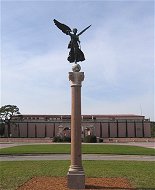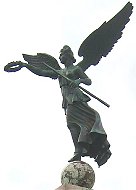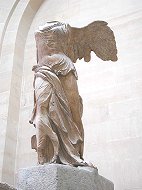Winged VictoryMuseum Label: Chiurazzi description: |
| Subject info: The Ringling Museum bronze (pictured here on the far left) is based on The Winged Victory of Samothrace, a marble sculpture (pictured left) discovered in 1863 on the island of Samothrace (in the north Aegean Sea) by a small team of excavators led by the French Consul at Adrianople. The sculpture was sent to Paris and installed in the Louvre, after the wings and part of the drapery had been reassembled. In 1950 some of her fingers and a palm were found in the Art Museum in Vienna. |
The right hand of The Victory was originally supposed to have held a trumpet (as on some Hellenistic coinage) and a model was made in support of this theory. Another idea was that the victor's crown was in the raised hand, and a bronze version of the sculpture thus equipped was made for the collector Engel-Gros by Cordonnier and published by the French archaeologist Reinach. However, the recently discovered finger fragments suggest that the sculpture held nothing -or, as one authority has proposed, at most a metal taenia between index finger and thumb
Nike is the goddess of victory in Greek Mythology. Homer does not personify Nike. She is the daughter of the giant Pallas and the river Styx in Hesiod and she is sent to fight on the side of Zeus against the Titans. Athens did not appear to have a separate cult for Nike. At first she was inseparably connected and confounded with Pallas Athena, the dispenser of victory, but she is gradually separated from her.
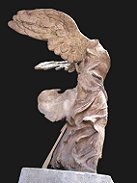 Winged Victory |
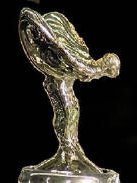 Rolls Royce Emblem |
Where do you think the Rolls Royce designers got their idea from to create their radiator and hood ornament ? |
Nike with Athena is always wingless while Nike as a separate goddess is always winged. Nike appears carrying a palm branch, wreath, or a caduceus of Hermes in works of art. Life was early associated with air because the need for air is so immediate. The birds flew in the air and were often associated with the spirit of life. Since a winged flight is associated with a victory over death it was easily associated with victory. Hense victory is associated with the winged goddess Nike. Nike is an aspect of Athena and is essentially an Athena with wings.
The Greek goddess Nike was the personification of victory in mythology. According to
the poet Hesiod, she was the daughter of the Titan Pallas and the Oceanid Styx. Hesiod's
Theogony features the following passage:
"Styx, the daughter of Okeanos, lay in love with Pallas and in his mansion gave birth
to Zelos and fair-ankled Nike, and then she bore two illustrious children, Kratos and
Bia."
Nike is therefore, according to Hesiod, the sister of three powerful siblings - Zelos
(Rivalry), Kratos (Strength), and Bia (Force).
Despite her ancestry, Nike fought on the side of the Olympian gods against the Titans, and
thus was considered a manifest representation of the victory of the Olympians.
This did not mean that Nike's powers were confined to the military sphere: quite the
contrary, in fact, for she symbolized victory in many areas of ancient Greek life,
including athletics (perhaps this is why the legendary shoe manufacturer borrowed the name
of this goddess) and other contests.
Images of Nike were popular in Greek art. Exquisite reliefs of the goddess, which are
collectively referred to as Nikai, grace the parapet of the temple of Athena Nike on the
Athenian Akropolis. In addition, one of the most famous depictions of the goddess of
victory is the Hellenistic masterpiece known as the Nike of Samothrace. See the
Mythography gallery page (link below) for images and details about these works of art.
Nike was called Victoria in Roman mythology.
N.B. - Some people pronounce the name as "Nee-kay". However, most experts
agree that the proper pronunciation in English spoken countries should be Nikee.
As in the sport shoe company. A billion shoes can't be wrong.
